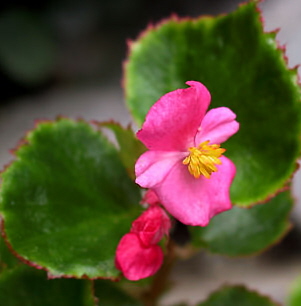Annuals
More Annuals
Perennials
Tips and Links
Gardening Terms
Gardening Links
Sitemap
Plant Doctor Blog
Vegetables
Tomatoes
Beans & Corn
Fall Salad Garden
Going Green
Starting a Garden
Lawn Care
Spring Bulbs
Summer Bulbs
House Plants
Plants in Containers Groundcovers
Growing Roses
Compost
Manure Tea
Frost Dates
Hardiness Zones
Winter Annuals
Please click on Google ads to support this site.
Please click on Google ads to support this site.

|
|
| Begonias are a good choice for shady areas that need colorful flowers. They are good growing in beds or in hanging pots.
The begonia most often grown in the garden is known as wax begonias because of their shiny, waxy leaves. Wax begonias have bright green leaves with some varieties having leaves that are bronze colored. Bronze leaf begonias are bred to grow in full sun, but they are best growing in about six hours or less of direct sun.
:Growing only six to 14 inches tall, begonias are generally grown at the front of a bed. Begonias can be grown from seeds but they get off to a slow start. The plants are usually purchased in six packs or in individual pots in the spring. Flower colors for wax begonias are white, red, coral, and pink. Angel wing begonias are taller (20 inches) with bigger leaves (shaped like an angel's) but are usually grown in containers as house plants. Other begonias grown indoors are rieger begonias and rex begonias. They are available as gifts in florist shops.
Any begonia grown inside, can last more than a year but need an occasional trimming. Begonias prefer light shade and a little more than average watering. In the garden, they will bloom until frost kills them.
Botanists have discovered more than 1000 species of begonia nearly all in the in tropical areas of Africa, Asia, or America, but the Chinese species Begonia grandis is hardy to USDA hardiness zone 6 (areas experiencing 10 degrees F as their coldest winter temperatures) and is commonly known as the "hardy begonia". It is available through mail order, or look on ebay for seeds. (see below).
Begonia likes rich soil. To keep the plants attractive, pick off dead flowers and any leaves that are turning brown.
Brown leaves on begonias may indicate too much sun with too little water. Yellow leaves may indicate soil that has been kept too wet.
Insects may also cause brown leaves on begonia. Tiny green bugs sucking on the plant are aphids, sprays containing pyrethrum can be effective. White spots that look like powdery flour are mealy bugs, remove the affected parts or discard the plant. Spider mites, small bugs with some cobwebbing, will cause plant leaves to have small spots, treat with insecticide or discard plant.
Holes in leaves may mean slugs are lunching on your garden flowers. Place small pots upside down in the garden. The slugs may take refuge there during the day, making them easy to dispose of.
|
|
Search here and click on ads to support this site.
 Cuttings can be used to make new begonias by cutting off pieces of stems, pulling off the lower leaves and rooting in moist soil or sand.
Cuttings can be used to make new begonias by cutting off pieces of stems, pulling off the lower leaves and rooting in moist soil or sand.